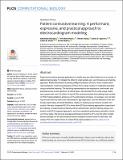| dc.contributor.author | Diamant, Nathaniel | |
| dc.contributor.author | Reinertsen, Erik | |
| dc.contributor.author | Song, Steven | |
| dc.contributor.author | Aguirre, Aaron D | |
| dc.contributor.author | Stultz, Collin M | |
| dc.contributor.author | Batra, Puneet | |
| dc.date.accessioned | 2022-07-20T17:33:16Z | |
| dc.date.available | 2022-07-20T17:33:16Z | |
| dc.date.issued | 2022 | |
| dc.identifier.uri | https://hdl.handle.net/1721.1/143901 | |
| dc.description.abstract | <jats:p>Supervised machine learning applications in health care are often limited due to a scarcity of labeled training data. To mitigate the effect of small sample size, we introduce a pre-training approach, <jats:bold>P</jats:bold>atient <jats:bold>C</jats:bold>ontrastive <jats:bold>L</jats:bold>earning of <jats:bold>R</jats:bold>epresentations (PCLR), which creates latent representations of electrocardiograms (ECGs) from a large number of unlabeled examples using contrastive learning. The resulting representations are expressive, performant, and practical across a wide spectrum of clinical tasks. We develop PCLR using a large health care system with over 3.2 million 12-lead ECGs and demonstrate that training linear models on PCLR representations achieves a 51% performance increase, on average, over six training set sizes and four tasks (sex classification, age regression, and the detection of left ventricular hypertrophy and atrial fibrillation), relative to training neural network models from scratch. We also compared PCLR to three other ECG pre-training approaches (supervised pre-training, unsupervised pre-training with an autoencoder, and pre-training using a contrastive multi ECG-segment approach), and show significant performance benefits in three out of four tasks. We found an average performance benefit of 47% over the other models and an average of a 9% performance benefit compared to best model for each task. We release PCLR to enable others to extract ECG representations at <jats:ext-link xmlns:xlink="http://www.w3.org/1999/xlink" ext-link-type="uri" xlink:href="https://github.com/broadinstitute/ml4h/tree/master/model_zoo/PCLR" xlink:type="simple">https://github.com/broadinstitute/ml4h/tree/master/model_zoo/PCLR</jats:ext-link>.</jats:p> | en_US |
| dc.language.iso | en | |
| dc.publisher | Public Library of Science (PLoS) | en_US |
| dc.relation.isversionof | 10.1371/JOURNAL.PCBI.1009862 | en_US |
| dc.rights | Creative Commons Attribution 4.0 International license | en_US |
| dc.rights.uri | https://creativecommons.org/licenses/by/4.0/ | en_US |
| dc.source | PLoS | en_US |
| dc.title | Patient contrastive learning: A performant, expressive, and practical approach to electrocardiogram modeling | en_US |
| dc.type | Article | en_US |
| dc.identifier.citation | Diamant, Nathaniel, Reinertsen, Erik, Song, Steven, Aguirre, Aaron D, Stultz, Collin M et al. 2022. "Patient contrastive learning: A performant, expressive, and practical approach to electrocardiogram modeling." PLoS Computational Biology, 18 (2). | |
| dc.contributor.department | Massachusetts Institute of Technology. Research Laboratory of Electronics | |
| dc.contributor.department | Massachusetts Institute of Technology. Department of Electrical Engineering and Computer Science | |
| dc.contributor.department | Harvard University--MIT Division of Health Sciences and Technology | |
| dc.relation.journal | PLoS Computational Biology | en_US |
| dc.eprint.version | Final published version | en_US |
| dc.type.uri | http://purl.org/eprint/type/JournalArticle | en_US |
| eprint.status | http://purl.org/eprint/status/PeerReviewed | en_US |
| dc.date.updated | 2022-07-20T17:03:37Z | |
| dspace.orderedauthors | Diamant, N; Reinertsen, E; Song, S; Aguirre, AD; Stultz, CM; Batra, P | en_US |
| dspace.date.submission | 2022-07-20T17:03:38Z | |
| mit.journal.volume | 18 | en_US |
| mit.journal.issue | 2 | en_US |
| mit.license | PUBLISHER_CC | |
| mit.metadata.status | Authority Work and Publication Information Needed | en_US |
